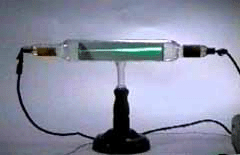| FIGURE 4.1 Diagram of a cathode-ray tube. |

An atom is very small. Its mass is between 10-21 and 10-23g.
A row of 107 atoms (10,000,000 atoms) extends only 1.0 mm. We know
that atoms contain many different subatomic particles such as electrons, protons,
and neutrons, as well as mesons, neutrinos, and quarks. The atomic model used
by chemists requires knowledge of only electrons, protons, and neutrons, so
our discussion is limited to them.
A. The Electron
An electron is a tiny particle with a mass of 9.108 X 10-28g and
a negative charge. All neutral atoms contain electrons. The electron was discovered
and its properties defined during the last quarter of the nineteenth century.
The experiments that proved its existence were studies of the properties of
matter in gas-discharge or cathode-ray tubes.
| FIGURE 4.1 Diagram of a cathode-ray tube. |

Figure 4.1 is a diagram of a cathode-ray tube. This apparatus consists of a glass tube sealed at both ends. Within the tube are two metal plates called electrodes, which are connected to an outside power supply. If the tube is full of air or some other gas, no current flows between the electrodes, regardless of how large a voltage is applied from the power source. If the tube has been partially evacuated before sealing (that is, almost all the gas has been pumped out of it), the application of a high voltage from the power source across the two electrodes gives rise to a glow inside the tube, and simultaneously, a current begins to flow between the electrodes. We need not discuss in detail the various experiments performed with this apparatus; we will only state the conclusions drawn from them. The current is carried by streams of tiny particles given off by the negative electrode, called the cathode. The positive electrode is called the anode. The tiny particles are called electrons.
In these experiments, the presence of these electrons and their properties did not change if the metal of the electrode was changed, nor were any changes observed in their properties when different gases were used in the tube. Eventually, the experimenters became convinced that all matter contains electrons.
Each electron carries a single, negative electric charge and has a mass of 9.108 X 10-28g. Because the mass of an atom is approximately 10-23g, the mass of an electron is negligible compared to that of an atom.
B. The Proton
Gas-discharge tubes of slightly different design were used to identify small,
positively charged particles that moved from the positive electrode (anode)
to the negative electrode (cathode). The mass and charge of these particles
varied but were always a simple multiple of the mass and charge of the positive
particle observed when the gas-discharge tube contained hydrogen. The particle
formed from hydrogen is called the proton.
The mass of a proton is 1.6726 X 10-24g, or about 1836 times the mass of an electron. The proton carries a positive electrical charge that is equal in magnitude to the charge of the electron but opposite in sign. All atoms contain one or more protons.
C. The Neutron
The third subatomic particle of interest to us is the
neutron.
Its mass of 1.675 X 10-24g is very close to that of the proton. A neutron carries no charge. With the exception of the lightest atoms of hydrogen, all atoms contain one or more neutrons.
The properties of these three subatomic particles are summarized in Table 4.1. The third column of the table lists the relative masses of these particles.
| Particle | Actual mass (g) | Relative mass (amu) |
Relative charge |
|---|---|---|---|
| proton | 1.6726 X 10-24 |
|
|
| neutron | 1.6749 X 10-24 |
|
|
| electron | 9.108 X 10-28 |
|
|
Because the actual masses of atoms and subatomic particles are so very small, we often describe their masses by comparison rather than in SI units, hence the term relative mass. If a proton is assigned a mass of 1.007, then a neutron will have a relative mass of 1.008 and an electron a mass of 5.45 X 10-4. When talking about relative masses, we use the term
atomic mass unit
(amu). Using this unit, a proton has a mass of 1.007 amu, a neutron a mass of 1.008 amu, and an electron a mass of 5.45 X 10-4 amu. Charges, too, are given relative to one another. If a proton has a charge of +1, then an electron has a charge of -1.